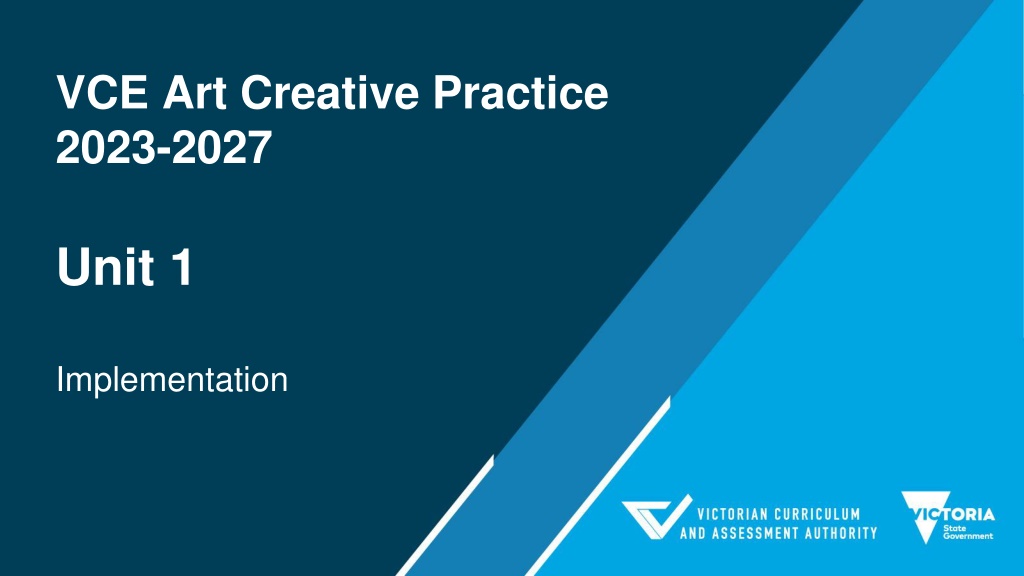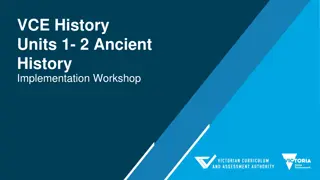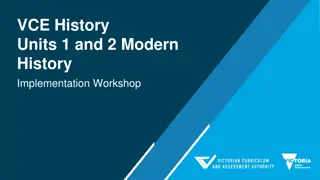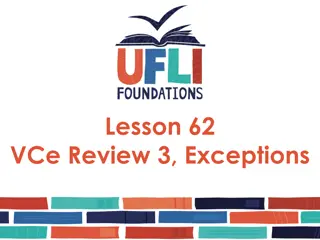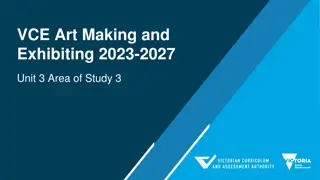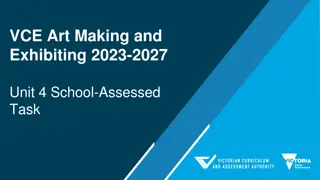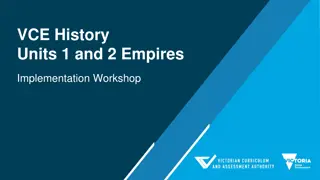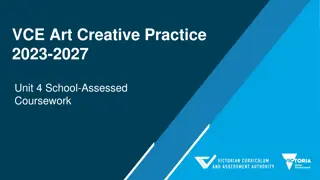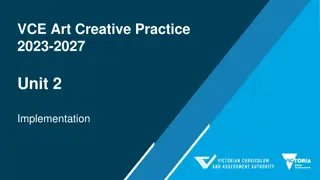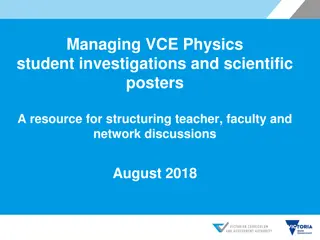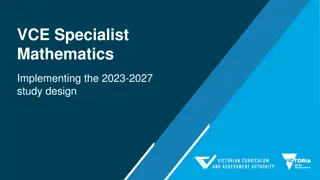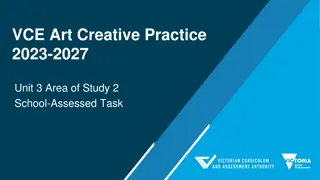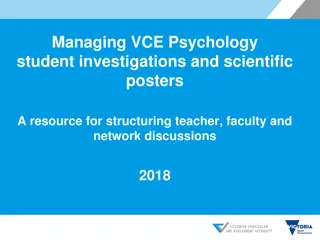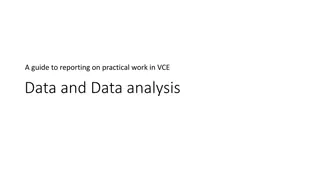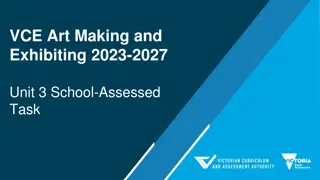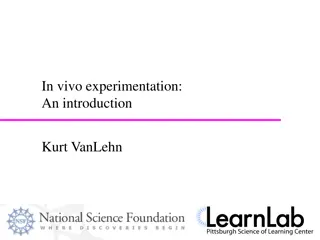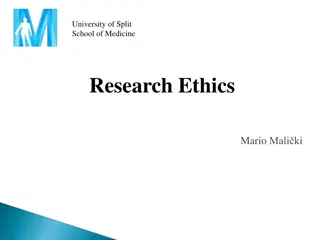Exploring the Creative Practice in VCE Art: Research, Experimentation, and Development
Dive into the world of VCE Art Creative Practice with a focus on research, experimentation, and development. Discover how artists explore and interpret personal, cultural, and social influences through visual language. Uncover the process of researching ideas, materials, and techniques, as well as experimenting with various elements to create meaningful artworks.
Download Presentation

Please find below an Image/Link to download the presentation.
The content on the website is provided AS IS for your information and personal use only. It may not be sold, licensed, or shared on other websites without obtaining consent from the author. Download presentation by click this link. If you encounter any issues during the download, it is possible that the publisher has removed the file from their server.
E N D
Presentation Transcript
VCE Art Creative Practice 2023-2027 Unit 1 Implementation
VCE Art Creative Practice Unit 1 Outline Features of Unit 1 VCE Art Creative Practice Overview of the areas of study Teaching ideas Assessment ideas
VCE Art Creative Practice: Study specifications Inquiry learning Experiential learning Project based learning
VCE Art Creative Practice Study specifications: The Creative Practice research and investigation experimentation and development refinement and resolution reflection and evaluation. Inquiry learning Experiential learning Project based learning
The Creative Practice Research and exploration The research and exploration component of the Creative Practice includes: researching and exploring ideas based on experiences, observations and personal interest researching and exploring materials, techniques and processes in art forms to respond to personal, cultural and social influences and ideas researching and examining personal, cultural, historical and social influences that inform the exploration and development of artworks exploring, analysing and interpreting influences and ideas in artworks using the Interpretive Lenses exploring, analysing and evaluating how artists use visual language to communicate personal, cultural and social influences, ideas, beliefs and values.
The Creative Practice Experimentation and development The experimentation and development component of the Creative Practice includes: experimenting with materials, techniques and processes to develop artworks experimenting with personal ideas and responses experimenting with the influences of ideas, values and beliefs to develop artworks developing ideas in artworks through experimentation and exploration developing knowledge of art elements and art principles through experimentation and exploration to create visual language developing points of view and interpretations of the meanings and messages of artworks in different contexts using the Interpretive Lenses developing artworks in response to the research and exploration of and experimentation with visual language.
The Creative Practice Reflection and evaluation The reflection and evaluation component of the Creative Practice includes: analysing and evaluating artworks using the appropriate Interpretive Lenses analysing and evaluating the application of materials, techniques and processes to resolve ideas in artworks using the Interpretive Lenses critically analysing and evaluating how the symbolic values and beliefs of people, places and objects are assigned by artists and viewers or audiences analysing and evaluating how visual language can communicate ideas and meaning in artworks reflecting, analysing and evaluating using critique and feedback.
VCE Art Creative Practice Study specifications: Interpretive Lenses Through Making and Responding The Structural Lens informs the analysis and interpretation of an artwork, and its relationship with the artist and viewer or audience, through the investigation of the use of art elements and art principles, and the application of materials, techniques and processes. It also considers the stylistic qualities and symbolism evident in the artwork, and the context in which artists work and in which artworks are presented or viewed. Structural Lens The Personal Lens informs the analysis and interpretation of an artwork through the investigation of the personal feelings, beliefs and life experiences of the artist, viewer or audience. Personal Lens The Cultural Lens informs the analysis and interpretation of an artwork through the investigation of social, historical and cultural influences and representations. Cultural Lens
VCE Art Creative Practice The Visual diary A visual diary is used to record and document making and responding in Creative Practice. Students should be encouraged to use formats that suit their working method and the body of work that they are producing. Visual Arts diary form document boxes Sketchbooks bound or clipped together sheets, or portfolios digital formats for their visual diary such as an online repository. Visual Arts diary content Annotations Visual material Audio recordings Documentation that is numbered and dated
VCE Art Creative Practice Big Planning Ideas Inspiration A core focus of VCE Art Creative Practice is the place of the student artist in the world continuum of art making. The connection of the student to historical and contemporary art is crucial and students must be supported to regularly refer to the work of other artists and sources of inspiration. Selecting artworks for study Students should be encouraged to view artworks from a broad range of periods and cultures and experiment with a wide range of materials, techniques and processes. The study encourages teachers to take their students out of the classroom environment and inform their art making through visits to galleries and studios, and through experience working with practising artists, curators, critics and art historians.
VCE Art Creative Practice Big planning ideas Selecting artists for study Select artists for whom there is sufficient background information, so the inquiry can be deep and broad. Investigate the origins of the artist s practice more broadly and research the ideas and issues they represent in their work. Investigate the intention of the artist for the presentation of the work and for whom it is intended and why.
VCE Art Creative Practice Big planning ideas Art Forms VCE Art Creative Practice introduces students to a range of artists practice and artworks. It is important that in students engage with a range of art forms across Units 1 to 4. A list of art forms is on page 17 of the VCE Art Creative Practice study design along with a definition of materials, techniques and processes. Students must understand the specific use of materials, techniques and processes associated with the art form that is selected. Teachers should aim to expose students to a diverse range of art forms and how visual language is created by artists working in a specific art form.
VCE Art Creative Practice Big planning ideas In Unit 1 Area of Study 2, students are required to explore three artforms. The exploration may link to Area of Study 1 focusing on the practices of three artists from different periods of time and cultures. Artists may work in multiple art forms in their practice so therefore students could investigate artists that have a multi-disciplinary approach to their practice. A similar approach could be undertaken when artists are investigated in Units 3 and 4 Areas of Study 1 and 2.
VCE Art Creative Practice Unit 1: Interpreting artworks and exploring the Creative Practice Inquiry and experiential learning Students explore Making and Responding using the Creative Practice Focus on artists and their practice Personal identity and interest in Making and Responding Understand the Structural and Personal Lenses Area of Study Content summary On completion of this unit the student should be able to discuss the practices of three artists, and apply the Structural Lens and the Personal Lens to analyse and interpret one artwork by each artist. Area of Study 1 Artists, artworks and audiences On completion of this unit the student should be able to use the Creative Practice to develop and make visual responses informed by their exploration of personal interests and ideas. Area of Study 2 The Creative Practice On completion of this unit the student should be able to document and evaluate the components of the Creative Practice used to make personal visual responses. Area of Study 3 Documenting and reflecting on Creative Practice
VCE Art Creative Practice Unit 1 Area of Study 1: Artists, artworks and audiences On completion of this unit the student should be able to discuss the practices of three artists, and apply the Structural Lens and the Personal Lens to analyse and interpret one artwork by each artist. Outcome 1 Inquiry learning Guiding questions How do artists conceptualise artworks? How do artists communicate ideas and meaning? How are personal ideas and viewpoints communicated in artworks? How do audiences interpret artworks? What is the relationship of the artists intention to the presentation of the artwork in different contexts? What components of the Creative Practice do I use to explore artists and artworks? How do I use visual language to express ideas? What questions do I use when applying the Structural Lens to the analysis and interpretation of an artwork? Learning structure
VCE Art Creative Practice Unit 1 Area of Study 1: Artists, artworks and audiences Key knowledge the practices of artists from different periods of time and cultures the use of the Structural Lens and the Personal Lens to analyse and interpret artworks the use of personal opinions and points of view about artworks the ways artists use visual language to communicate ideas and meaning in their artworks terminology used in discussion of artists and their artworks
VCE Art Creative Practice Unit 1 Area of Study 1: Artists, artworks and audiences Key skills analyse and discuss the practices of artists from different periods of time and cultures apply relevant aspects of the Structural Lens and the Personal Lens to analyse and interpret artworks formulate and justify personal opinions with reference to artworks and related sources analyse and discuss how artists use visual language to communicate ideas and meaning in their artworks use appropriate art terminology and references to a range of sources in the discussion of artists and their artworks
VCE Art Creative Practice Unit 1 Area of Study 1 Inquiry learning activities The research of artists and artworks can start with a designed question or prompt based on a common theme or personal point of view about a series of artworks that the student has selected. The question is designed so that the research is open ended, and student directed The unit is based on contexts and the relationship of artists, artworks and audiences. A definition of contexts is provided in the Terms used in the Study on page 17. A context could be selected as a starting point Learning activities can be structured around inquiry-based questions about the visual language used by artists Explore the components of the Creative Practice using Inquiry learning. Look at the key words in each component and how they would lend themselves to inquiry learning Students use critical and creative thinking techniques to structure their inquiry learning. They develop questions relating based on their interests and approaches to their research.
VCE Art Creative Practice Unit 1 Area of Study 1 Teaching and Learning Ideas The selection of artists should expand the perspectives of the student. Consider local artists and the interests of the students. Example 1: Students could work individually or together to present the information on the composition, technique, style of each artwork and outline how each artwork relates to each of the three artist s lives. Presentation could be in the form of a documentary, PowerPoint, Video, or paper. Example 2: Students use a theme such as Self-portraiture and discuss the statement that Self-portraiture has been described as an artist s inner dialogue . Students analyse and interpret the work of artists such as; a) Rembrandt van Rijn, Romaine Brooks, Cindy Sherman b) Artemisia Gentileschi, Joy Hester, Trevor Turbo Brown
VCE Art Creative Practice Unit 1 Area of Study 1 Detailed learning example Investigate, analyse and interpret a work by three different artists from different periods of time and cultures. Use the following as an example for each artist. Learning activities Artist: Research and cite three different sources to learn about the life and work of the artist. Print out a copy of the artwork to study and annotate Use the Structural and Personal lenses to analyse and interpret the work Date of Birth/Death: Nationality: Title of Art work: Date: Technique/Medium: Subject matter: What can be seen in the artwork that tells us about the life of the artist? What symbols can be seen in the artwork, and what do they mean? Identify how the artist uses the Art elements and principles to communicate meaning What is the student s interpretation and response to the work? Does it relate to their own life? Explain. Consider the context within which the work is viewed, who the intended audience is and how different audiences might respond differently to the work.
VCE Art Creative Practice Unit 1 Area of Study 1 Assessment . On completion of this unit the student should be able to discuss the practices of three artists, and apply the Structural Lens and the Personal Lens to analyse and interpret one artwork by each artist. Examples such as: an extended written response short-answer responses supported by visual references an annotated visual report a presentation using digital technologies such as an online presentation or interactive website an oral presentation In Area of Study 1, the three artists selected for study must be from different periods of time and cultures and include at least one contemporary artist and at least one Australian artist.
VCE Art Creative Practice Unit 1 Area of Study 1 Assessment Example Students view historical and contemporary artworks. They research, analyse and interpret three artists Artist; Date of Birth/Death; Nationality Title; Date; Technique/Medium; Subject matter; Image Historical or Contemporary Research Choose artists for whom there is sufficient background information, so the inquiry can be deep and broad. The sources should be many, varied, reliable. Acknowledge and record all sources. Describe - Use the Interpretive Lenses questions. Provide a general overview Analyse - Use the Interpretive Lenses questions to analyse the work Interpret the meanings and messages of the artworks using the Interpretive lenses Opinion Formulate and justify an opinion. What do I think or feel? What do I think of the artwork? Why? What evidence supports your response?
VCE Art Creative Practice Unit 1 Area of Study 2: The Creative Practice On completion of this unit the student should be able to use the Creative Practice to develop and make visual responses informed by their exploration of personal interests and ideas. Outcome 2 Experiential learning guiding questions How do artists explore and experiment with materials, techniques and processes in their practice? How do artists explore ideas in their practice? How do I respond to artworks? What are the practices I use? How do I explore visual language in artworks? What components of the Creative Practice do I use to respond to artworks? How does the relationship between the artist, artwork and audience communicate meaning? How do I communicate my ideas in my artworks? What aspects of the Structural and Personal lenses will I use to interpret meanings in artworks and develop personal responses? Learning structure
VCE Art Creative Practice Unit 1 Area of Study 2: The Creative Practice Key knowledge methods used to experiment with and explore materials, techniques and processes using the Creative Practice ways to develop personal visual responses by investigating the practices of artists the use of visual language to communicate ideas of personal interest inherent properties of materials and their use in a range of art forms the use of materials, techniques and art forms to make personal visual responses ways the relationships between the artist, the artwork and the viewer or audience communicate meaning in artworks the use of the Structural Lens and the Personal Lens to interpret meaning in visual responses
VCE Art Creative Practice Unit 1 Area of Study 2: The Creative Practice Key skills experiment with and explore materials, techniques and processes using the Creative Practice investigate the practices of artists to develop personal visual responses use visual language to communicate ideas of personal interest explore and experiment with materials, techniques and processes in a range of art forms to make personal visual responses explore how the relationships between the artist, the artwork, and the viewer or audience communicate meaning in artworks apply the Structural Lens and the Personal Lens to interpret meaning in visual responses
VCE Art Creative Practice Unit 1 Area of Study 2 Experiential learning activities Students could base their experimentation using a personal exploration and choice of experimenting with new materials. Students are required to experiment with three art forms. The artforms selected by the student could be their personal choice based on their research of artists in Area of Study 1. They could explore a similar practice to the artist and extend on their ideas through the experimentation of materials and techniques. The students investigate the relationships between the artwork, audience and artists in a range of contexts. They can explore these relationships based on personal feelings, opinions and viewpoints and how meaning is intended by artists and interpreted by viewers
VCE Art Creative Practice Unit 1 Area of Study 2 Teaching and Learning Ideas In Unit 1 Area of Study 2 Outcome 2 students are introduced to Experiential learning. The learning activities are teacher guided. Teachers use the Creative Practice to ensure students develop visual responses from an exploration of personal interests and ideas. Investigation the practices of three artists and artforms, teachers or students may choose their own groups of artists. Example 1: Use textile, photography and painting to experiment with the art element tone or the art principle form. Example 2: Use found objects to experiment with art materials, techniques, construction/deconstruction, and form. Example 3: Consider the methods of abstract expressionist painters who used mops, water, sponges, and experiment with making gestural actions. Repeat the process on a smaller scale on paper.
VCE Art Creative Practice Unit 1 Area of Study 2 Detailed learning example Use the work of artists as a starting point to investigate, explore and experiment with three different artforms. Investigate a painting process, a printmaking process and a ceramics process. Select an artist for each art form and introduce the students to the art forms through the work of the artists. Guide the students through the relevant materials and techniques and processes, allowing space and time for the student to make discoveries about the form. Ensure you allocate an equal amount of time for each artform.
VCE Art Creative Practice Unit 1 Area of Study 2 Assessment . On completion of this unit the student should be able to use the Creative Practice to develop and make visual responses informed by their exploration of personal interests and ideas. Students produce a range of personal visual responses to a selection of set tasks, showing the exploration of ideas, materials and techniques in at least three art forms. Finished artworks are not an expectation of this outcome but can be considered in the student s use of the Creative Practice.
VCE Art Creative Practice Unit 1 Area of Study 2 Assessment Example The teacher selects a minimum of three different artforms for students to explore and experiment No finished works are made. Students respond to a range of artworks, ideas and the practices of artists through experimentation and exploration, build skills using materials, techniques and processes, and explore areas of personal interest to develop and make visual responses. Questions to ask for assessment may include; How have the selected artists used the artform and does this inform the students work? Has the student experimented with different art materials, techniques, processes to discover their specific characteristics? Has the student explained which of the explorations of materials, techniques or processes are most interesting? Does the material, technique or process have a limit, if so, how far has the student taken the materials, techniques, or processes? How did the student get the best result from the material, technique, process?
VCE Art Creative Practice Unit 1 Area of Study 3: Documenting and reflecting on the Creative Practice On completion of this unit the student should be able to document and evaluate the components of the Creative Practice used to make personal visual responses. Outcome 3 Experiential learning guiding questions What strategies are used by artists to reflect upon and evaluate their artistic practice? What components of the Creative Practice will I use to document and reflect upon my artistic practice? In what format will I document my art practice? How will I structure my documentation? How is visual language documented? What strategies will I use to critically analyse and evaluate personal explorations and visual responses? What aspects of the Structural and Personal Lens will I use to analyse and reflect upon visual responses? Learning structure
VCE Art Creative Practice Unit 1 Area of Study 3: Documenting and reflecting on the Creative Practice Key knowledge methods used to document and evaluate the use of the Creative Practice approaches to making and presenting visual responses that communicate ideas of personal interest the use of critical and reflective thinking throughout the Creative Practice methods used to reflect on and evaluate visual language methods used to evaluate the use of materials, techniques and processes in personal visual responses the use of the Structural Lens and the Personal Lens in annotations to analyse and reflect upon visual responses
VCE Art Creative Practice Unit 1 Area of Study 3: Documenting and reflecting on the Creative Practice Key skills document and evaluate the use of the Creative Practice, using written and visual documentation analyse and reflect upon ideas of personal interest communicated in visual responses use and document critical and reflective thinking throughout the Creative Practice document and evaluate the development of visual language document and evaluate the materials, techniques and processes used to make personal visual responses apply the Structural Lens and the Personal Lens in annotations to analyse and reflect upon visual responses
VCE Art Creative Practice Unit 1 Area of Study 3 Experiential learning activities The structure of the student experiences will govern the structure of their reflection and their creative and critical thinking to evaluate their use of the Creative Practice Documentation of the students experimentation and exploration is both written and visual and can be based on personal experience. The documentation can be a highly personal reflection of the student experiences and experimentation with the three selected artforms.
VCE Art Creative Practice Unit 1 Area of Study 3 Teaching and Learning Ideas Students must use the language from the Interpretive lenses to annotate their progressive critical reflections that are made during the exploration and experimentations in Area of Study 2 Example: Students use photos, sketches or diagrams to document and evaluate techniques and processes, exploration and experiments and personal visual responses Simple questions for students to ask themselves may include; What did I do? How did I do it? What did I find out? What will I do next? What will I not repeat? Why?
VCE Art Creative Practice Unit 1 Area of Study 3 Detailed learning example For each artform, make photographs, sketches and notes that critically evaluate personal visual responses. The following is a list of headings for documentation in the Visual Diary: Date Visual responses Artform Inspiration Observations Activity Observations Personal response Developing visual language Critical evaluation
VCE Art Creative Practice Unit 1 Area of Study 3 Assessment . On completion of this unit the student should be able to document and evaluate the components of the Creative Practice used to make personal visual responses. Students document their use of the Creative Practice, including annotated personal visual responses to a selection of set tasks.
VCE Art Creative Practice Unit 1 Area of Study 3 Assessment Example Students document and evaluate the Creative Practice used to make personal visual responses. Assessment may critically evaluate how ideas were explored and communicated and an assessment template may be created and used by the student, teacher or class. Example 1: Students may have a round-table critique of the artform explorations to inform documentation. Example 2: Students may create an instructional video that explains how personal visual responses to a source of inspiration were created in a particular artform. Example 3: Students may critically evaluate their visual responses through diary entries, sketches and annotations.
Contact Dr Kathryn Hendy-Ekers Curriculum Manager Visual Arts, Visual Communication Design and Media E: Kathryn.Hendy-Ekers@education.vic.gov.au T: 9059 5147 M: 0438471513
